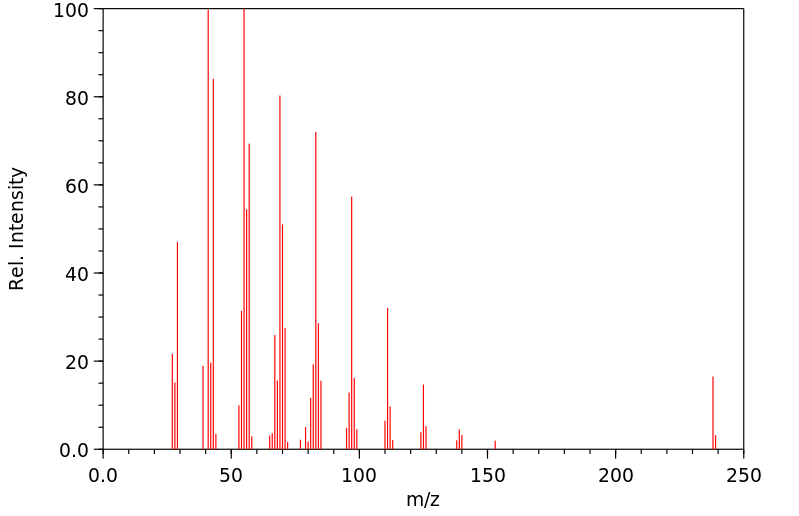(E)-heptadec-8-ene | 16416-42-5
中文名称
——
中文别名
——
英文名称
(E)-heptadec-8-ene
英文别名
(8E)-8-heptadecene;(E)-8-heptadecene;8-Heptadecene
CAS
16416-42-5
化学式
C17H34
mdl
——
分子量
238.457
InChiKey
BIQKRILZMDQPHI-BMRADRMJSA-N
BEILSTEIN
——
EINECS
——
-
物化性质
-
计算性质
-
ADMET
-
安全信息
-
SDS
-
制备方法与用途
-
上下游信息
-
文献信息
-
表征谱图
-
同类化合物
-
相关功能分类
-
相关结构分类
物化性质
-
沸点:305.4±9.0 °C(Predicted)
-
密度:0.787±0.06 g/cm3(Predicted)
-
保留指数:1676
计算性质
-
辛醇/水分配系数(LogP):8.5
-
重原子数:17
-
可旋转键数:13
-
环数:0.0
-
sp3杂化的碳原子比例:0.88
-
拓扑面积:0
-
氢给体数:0
-
氢受体数:0
SDS
上下游信息
-
上游原料
中文名称 英文名称 CAS号 化学式 分子量 正癸烯 1-Decene 872-05-9 C10H20 140.269
反应信息
-
作为反应物:描述:二甲基二硫 、 (E)-heptadec-8-ene 生成 8,9-bis(methylsulfanyl)heptadecane参考文献:名称:SCRIBE, P.;PEPE, C.;BAROUXIS, A.;FUCHE, CH.;DAGAUT, J.;SALIOT, A., ANALUSIS, 18,(1990) N, C. 284-288摘要:DOI:
-
作为产物:描述:反油酸 在 photodecarboxylase from Chlorella variabilis NC64A 作用下, 以 二甲基亚砜 为溶剂, 反应 4.5h, 生成 (E)-heptadec-8-ene参考文献:名称:脂肪酸的光驱动酶促脱羧摘要:提出将脂肪酸光催化脱羧成烷烃作为合成生物柴油的替代方法。通过使用最近发现的变异小球藻NC64A(CvFAP)的光脱羧酶,我们证明了不可逆地从脂肪酸和甘油三酸酯制备烷烃。CvFAP通过蓝光照射将几种脂肪酸及其甘油三酸酯转化为接近定量的产率和唯一选择性。在这项概念验证研究中,实现了非常有希望的营业额高达8000。DOI:10.1002/anie.201807119
文献信息
-
Insight into forced hydrogen re-arrangement and altered reaction pathways in a protocol for CO<sub>2</sub> catalytic processing of oleic acid into C<sub>8</sub>–C<sub>15</sub> alkanes作者:Shiyou Xing、Pengmei Lv、Haoran Yuan、Lingmei Yang、Zhongming Wang、Zhenhong Yuan、Yong ChenDOI:10.1039/c7gc01853c日期:——alkane products. The reaction pathway in the CO2 atmosphere is significantly different from that in the H2 atmosphere, as shown by the presence of 8-heptadecene, γ-stearolactone, and 3-heptadecene as reaction intermediates, as well as a CO formation pathway. Because of the highly dispersed Ni metal center on the zeolite support, H2 spillover is observed in the H2 atmosphere, which inhibits the production本文报道了在纳米镍/沸石催化剂上使用二氧化碳(CO 2)催化将油酸催化转化为C 8 –C 15烷烃的新观点。通过使用全新的在CO 2气氛中进行油酸转化的催化反应途径,可以清楚地解决使该问题得以实现的内在和必要原因。在CO 2气氛中C 8 -C 15成分的产率达到73.10 mol%,远高于在氢气(H 2)气氛中获得的49.67 mol%的产率。在没有外部H 2的情况下来源,产生了与航空燃料相似的产品,其中发现了涉及CO 2和丙烷的丙烯(C 3 H 6)氧化脱氢(ODH)的芳构化(C 3 H 8)和氢转移反应可解释油酸中氢的释放酸,并在最终的烷烃产品中实现重排。在CO 2气氛中的反应路径与在H 2气氛中的反应路径显着不同,如存在作为反应中间体的8-十七碳烯,γ-硬脂酸内酯和3-十七碳烯以及CO的形成路径所示。由于沸石载体上的Ni金属中心高度分散,H 2在H 2气氛中观察到溢出,这抑制了短链烷烃的产生,并揭示了使用H
-
Synthesis and Activity of Six-Membered Cyclic Alkyl Amino Carbene–Ruthenium Olefin Metathesis Catalysts作者:Adrian E. Samkian、Yan Xu、Scott C. Virgil、Ki-Young Yoon、Robert H. GrubbsDOI:10.1021/acs.organomet.9b00862日期:2020.2.24alkyl amino carbene (Ru–CAAC) olefin metathesis catalysts perform extraordinarily in metathesis macrocyclization and ethenolysis, but previous studies have been limited to the use of five-membered CAAC (CAAC-5) ligands. In this work, we synthesized a different group of ruthenium catalysts with more σ-donating and π-accepting six-membered CAAC (CAAC-6) ligands, and their metathesis activity was probed
-
Engineering Fatty Acid Photodecarboxylase to Enable Highly Selective Decarboxylation of <i>trans</i> Fatty Acids作者:Danyang Li、Tao Han、Jiadan Xue、Weihua Xu、Jian Xu、Qi WuDOI:10.1002/anie.202107694日期:2021.9.13disease caused by the intake of trans fatty acids, a method to eliminate trans fatty acids from foods has become a critical issue. Herein, we engineered fatty acid photo-decarboxylase from Chlorella variabilis (CvFAP) to selectively catalyze the decarboxylation of trans fatty acids to yield readily-removed hydrocarbons and carbon dioxide, while cis fatty acids remained unchanged. An efficient protein
-
Chemoselective Decarboxylative Protonation Enabled by Cooperative Earth‐Abundant Element Catalysis作者:Yen‐Chu Lu、Julian G. WestDOI:10.1002/anie.202213055日期:2023.1.16Combining simple iron and thiol catalysts allows carboxylic acids to be directly converted to C−H bonds under visible light irradiation. The cocatalytic system exhibits a wide scope, is scalable, and preliminary mechanistic studies suggest it functions via a tandem ligand-to-metal charge transfer (LMCT)/Hydrogen Atom Transfer (HAT) mechanism.
-
Normant,H.; Villieras,J., Comptes Rendus Hebdomadaires des Seances de l'Academie des Sciences, 1964, vol. 259, p. 1150 - 1152作者:Normant,H.、Villieras,J.DOI:——日期:——
表征谱图
-
氢谱1HNMR
-
质谱MS
-
碳谱13CNMR
-
红外IR
-
拉曼Raman
-
峰位数据
-
峰位匹配
-
表征信息
同类化合物
高密聚乙烯
香叶醇
顺式3-甲基-2-己烯
顺式-5-癸烯
顺式-5-甲基-2-己烯
顺式-5-庚烯-1-炔
顺式-4-癸烷
顺式-4-甲基-2-戊烯
顺式-4-甲基-2-戊烯
顺式-3-癸烯
顺式-3-甲基-3-己烯
顺式-3-甲基-2-庚烯
顺式-3-戊烯-1-炔
顺式-3,4-二甲基-3-己烯
顺式-3,4-二甲基-2-戊烯
顺式-3,4-二甲基-2-戊烯
顺式-2-甲基-3-己烯
顺式-2-壬烯
顺式-2-丁烯-D1
顺式-1.1.1-三甲基-2-丁烯
顺式-1-甲基-2-环丙基乙烯
顺式-1-甲基-2-乙烯基环戊烷
顺式-1-环戊基-1-辛烯
顺式-1-氘代-3-甲基-1-丁烯
顺式-(9ci)-2,3,3a,7a-四氢-4-(1-甲基乙基)-1H-茚
顺式-(2-丁烯基)环丙烷
顺式,顺式-2,4-己二烯
顺-环辛烯
顺-9-二十一碳烯
顺-6-十三碳烯
顺-5-甲基-1,3,6-庚三烯
顺-4-辛烯
顺-4-壬烯
顺-3-辛烯
顺-3-甲基-2-戊烯
顺-3-壬烯
顺-3-十三碳烯
顺-2-辛烯
顺-2-癸烯
顺-2-戊烯
顺-2-庚烯
顺-2-己烯
顺-2-丁烯
顺-2,2-二甲基-3-己烯
顺-1,3-戊二烯
顺,顺-1,9-环十六烷二烯
顺,顺,顺-环癸-1,3,5-三烯
间戊二烯
间二(4-吡啶基)苯
镁,二-2-丁烯基-







